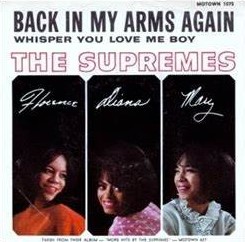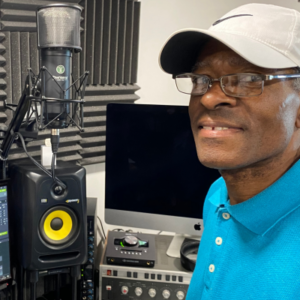The Supremes were the top act at Motown at the start of 1965. They had built a good understanding with Holland, Dozier, Holland and had achieved three number ones in 1964. The only question now was could the team sustain that unheard-of level of success. The song chosen to test that challenge was “Stop! In the Name of Love” and the answer to the question was a resounding yes.

The song later delivered their second gold certification from the RIAA, following the success of “Baby Love”, and charted in seven countries. It reached number one on the Billboard Hot 100 Singles Chart, number two on the Billboard R&B Singles Chart and number seven in the UK. It just failed to win the 1966 Grammy for Best Contemporary Rock & Roll Group Vocal Performance.

The follow-up by the same team was released in April and sailed to number one on both the Billboard Hot 100 and the R&B Chart (their first R&B number one!). “Back In My Arms Again” also later brought another gold disc from the RIAA. The studio band was small but highly effective: Earl Van Dyke, Joe Messina, James Jamerson, Benny Benjamin, James Gittens (vibraphone) and Mike Terry (baritone sax).
As usual at Motown, the same formula was applied again in July, in the expectation of another blockbuster, but Berry Gordy got a real shock when “Nothing But Heartaches” only reached number eleven on the Billboard Hot 100 Singles chart and number six on the Billboard R&B Singles chart. It did chart around the world, and it did sell over a million copies, but the standard expected was higher than that. Gordy issued a memo to everyone involved: “We will release nothing less than Top Ten product on any artist; and because the Supremes’ world-wide acceptance is greater than the other artists, on them we will only release number-one records”. Just to make sure that everyone got the message, he pulled the next projected Supremes single, “Mother Dear”, and told the production team to find something new and better.

In October, the response was unveiled to the market. Holland, Dozier, Holland had come up with a more complex song, “I Hear A Symphony”, weaving a strong lead vocal, soaring harmonies and several key changes. The vibraphone sets the tone. Diana Ross has said that this is one of her favourite songs to perform and it certainly sounds like she was really trying to do the song justice. The result was another number one, another unofficial gold disc and world-wide sales of over two million copies. It only made number two on the Billboard R&B Singles chart, but Berry Gordy was probably happy!
There was still time for one more single before the end of the year. “My World Is Empty Without You” appeared on December 29th. In addition to the five singles, Motown also released six Supremes albums over the course of the year, out of a total of only seventeen issued by the various Motown labels. It is a high proportion, which clearly indicates how much Berry Gordy now saw Diana Ross as the jewel in Motown’s crown.
Two of the six albums form a set, along with “A Bit of Liverpool” from 1964, show the Supremes looking outside Detroit for inspiration. February’s “The Supremes Sing Country Western and Pop” seems an odd choice. The next album, “We Remember Sam Cooke”, issued in April, makes much more sense.

In addition the group released a compilation in July, “More Hits by the Supremes”, followed by a live album on November 1st entitled “The Supremes at the Copa”. On the same day, Motown also released the Supremes’ “Merry Christmas” album, with a collection of Christmas songs arranged by Gene Page, Ernie Freeman and H.B. Barnum.
This sequence of albums shows the group working outside the usual parameters, with a variety of producers and musicians. “A Bit of Liverpool” was produced by West Coast producers Hal Davis and Marc Gordon and recorded in Los Angeles, the Country & Western album was produced by Clarence Paul and Lawrence Horn, while the Sam Cooke tribute album was the work of Davis, Gordon and Harvey Fuqua.
For the compilation album Holland and Dozier took charge, followed by Berry Gordy and Lawrence Horn producing the live album, with Gil Askey responsible for arrangements and conducting at the show. Finally, the Christmas album was produced by Harvey Fuqua, with the instrumental tracks laid down at Sunset Sound Studios in Hollywood and the vocals added back in Detroit.
The Supremes had clearly been given the task of taking the music of Motown to as wide an audience as possible. Sadly, the albums have few examples of real inspiration.
The Supremes were still the top Motown group, however, and Berry Gordy gave them priority. In 1966 they were looking to build on the outstanding results achieved in 1964 and 1965, and they didn’t wait long to make a start. “My World Is Empty Without You”, released at the end of December 1965, reached number five on the Billboard Hot 100 Singles Chart and number ten on the Billboard R&B Singles Chart, selling over a million copies to subsequently bring the group their eighth gold certification from the RIAA.
The follow-up in April, “Love Is Like an Itching in My Heart”, reached numbers nine (Hot 100) and seven (R&B), but did not hit the million-sales mark. It was a disappointment, and Motown’s response was, as ever, just to try harder.
Back in the studio in the Summer, the Supremes recorded a number of songs with an elite band of Funk Brothers: Earl Van Dyke (piano), Robert White (guitar), Benny Benjamin (drums), James Jamerson (Bass) and Jack Ashford (tambourine). Two songs were chosen for release. First came “You Can’t Hurry Love” in July and then “You Keep Me Hangin’ On” in October. Both songs topped the Billboard Hot 100 and the R&B Singles charts, and both later earned a gold disc from the RIAA. The first went platinum in the UK, as the song reached number three on the UK Official Pop Singles chart. The double number one was quite rare, but the Supremes and Holland, Dozier, Holland were making it look easy!

The Supremes February 1966
Photo: Publicity Shot from the Ed Sullivan Show on CBS Television
(Wikimedia Commons)
The group also had two studio albums released in 1966, “I Hear a Symphony” in February and “The Supremes A’Go-Go” in August, both of which sold well. The first reached number eight on the Billboard 200 Albums Chart and number one on the Billboard Soul & R&B Albums Chart. The second was number one on both charts, setting another record. The trio was the first female vocal group to have a number one album in the modern era.

An interesting footnote to the Supremes’ success also occurred in 1966. Local radio DJ Scott Regan ran a competition towards the end of the year for local amateur singers. The prize was to record a song with Mary Wilson and Florence Ballard at Detroit’s Golden World Studios. The record was then to be distributed free by Motown. A young lady named Christine Schumacher emerged as the winner of the competition; she was a sixteen-year-old student from Wilson Junior High School, who was blind. The two Supremes duly backed Christine Schumacher for the recording of “Mother You, Smother You” on December 15th 1966. The song had been written by Holland, Dozier, Holland and R. Dean Taylor.

















